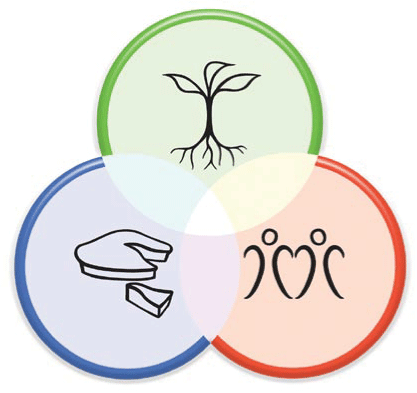I have been working with Nathaniel Richand and Julien Rayneau to propose occasional community meetups for people who want to use their professional skills towards a social and/or ecological impact. We call these meetups #demain nights (French word for “tomorrow”… it is based in Paris afterall). But we found we do not have to wait for tomorrow as today we can already use our skills for “good”. Whether at work, in outside structures – pro bono, or in the private or political sphere… there are a myriad of ways! And no way too small! But this post is not about that (entirely).
This post is about our last meetup where we explored a new workshop format to help this future dreaming and next step planning: La Fresque de la Rénaissance Écologique – The Fresco of the Ecological Renaissance by Julien Dossier. I will share my reflections and perhaps this can inspire you in your actions.
How does the Fresco Work?
The fresco (which is a large wall black-and-white poster) is quite a strong visual tool that can be used from a light theme to a deep dive. It was inspired by the fresco called “The Allegory of the Effects of Good Government” painted in 1338 in Sienna, Italy by Lorenzetti. The Fresco of the Ecological Renaissance, much like it’s predecessor, materializes a desired world, in this case, one that is sustainable and carbon-neutral. The fresco is used to unite citizens and actors with a cause by creating a common vision… and best yet, one that is exciting and fun! Which, I strongly believe, fun while we work is necessary more than ever.
A session with the fresco gives participants the mission: To explore the new world presented and reflect on how that makes us feel and how we can act right now to get there. Even when participants go off into their own projects and ideas they can always come back to the fresco, as a common reference. It creates a common language without words. And as a physical object can also be manipulated… colored, written on, notes added to, moved from one common space to another, built upon, etc. Also due to no words, the fresco can even be used with children!
Workshops using the Fresco can vary in time and objective but a good example for a taster session is as follows. The participants split into groups and each group has a separate mission to explore, such as, transport options that are carbon-neutral or food re-distribution. The groups spend time in individual and group contemplation. They discuss what they see and their reactions. They note on, color or what they like, on the fresco. They decide on a project that could be done and then share this back with the global group. We then discuss what this evokes and our next steps forward in the “actual” world.
The result? Ask Pandora…
Here are the words that were evoked in the participants:
The word at the center? Hope.
Did we feel doom and gloom and scarcity? No, it was… Serenity, Peace, Frugality/Sufficiency, Inclusion, Free Time, Respect, Know-How, Sense, Freshness, Proximity and Doable!
On a personal note: It struck me how reachable this new world could be! No crazy technology to save us, just a shift in mindset (I know easier said than done) and everyone doing their part, much like an ant hill. Complex yet doable when each of us does what inspires us (*cough* Agile *cough*). No one is “perfect” but we are “together” with a common goal even if our methods differ. And in fact stronger thanks to our diversity of interest! It can feel overwhelming and scary but as we share the news and hope and each person acts… 🤝A big and good change is coming. Fear not, just act.
Enough, of my prose… Bref, (as they say in French), it was really cool! And I know it already inspired me to get more local and involved in my neighborhood townhall’s sustainability projects.
Want More info?
- Parisian and wanting to use your pro-skills for impact? Normally we host our #demain nights at the agilist cooperative AgileTribu. Big thanks to them! Stay tuned for news by signing up for their meetup group.
- Want to do a Fresco or get involved with this type of tool? To signup to be part of the association or use the Fresco of the Ecological Renaissance you can contact Emmanuelle Mouls or learn more at the website https://www.renaissanceecologique.fr/ or read the book (see website).
- Questions of how you can bring eco and social responsibility to your business? – I am a transformation coach. I work with companies to create system and culture change. I would love to help you realize your social and ecological vision: via new ways of organisation, measurement, business models, product offers and engagement of employees and your eco-system. But first I start with your unique… Why. Send me an email. Let’s have fun!








